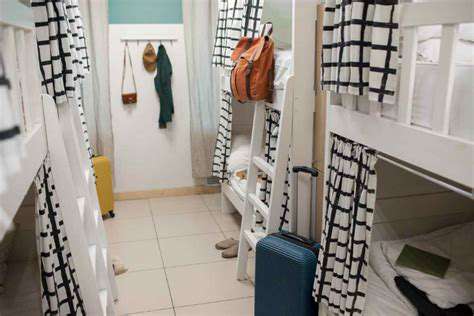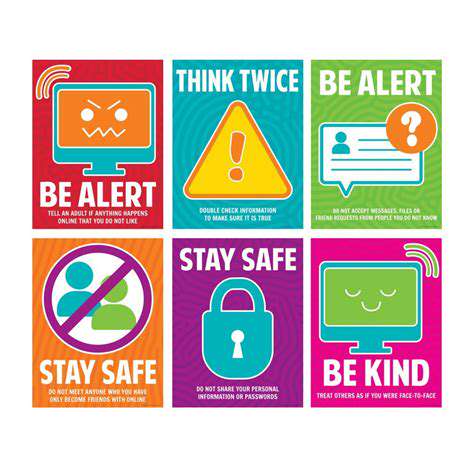Travel Safety for Solo Female Travelers
Understanding Your Destination
Before embarking on your solo journey, meticulous research is paramount. Familiarize yourself with the local laws, customs, and potential safety concerns specific to your chosen destination. This includes understanding potential scams, common petty theft tactics, and areas to avoid at night. Knowing the local emergency numbers and the nearest embassy or consulate is crucial for any unforeseen circumstances.
Thoroughly investigate the safety record of your chosen accommodation. Read reviews from other travellers, focusing on aspects like security measures and proximity to amenities. If staying in a hostel or guesthouse, inquire about safety protocols and the presence of security personnel. This proactive measure can significantly enhance your overall safety and peace of mind.
Preparing Your Itinerary
Creating a detailed itinerary, including planned activities and transportation, is essential. Share your itinerary with a trusted friend or family member, outlining your daily schedule and estimated return times. This allows them to be aware of your whereabouts and contact information if needed. Consider using a travel app to document your route and share your location periodically.
Securing Essential Documents
Safeguarding your passport, visa (if required), and other essential travel documents is critical. Make photocopies of these documents and store them separately from the originals. Keep a digital copy of these documents on your phone or in a cloud storage service in case of loss or theft. Consider a secure travel wallet or money belt to keep important documents and cash readily available but concealed.
Staying Connected and Aware
Maintain constant contact with someone back home, sharing your location periodically. This isn't just about providing a safety net; it's about having a point of contact for emergencies. Consider purchasing a local SIM card for easy communication and data access. Familiarize yourself with local emergency numbers and important phrases in the local language.
Remain vigilant and aware of your surroundings at all times. Avoid walking alone in dimly lit or deserted areas at night. Trust your instincts; if a situation feels uncomfortable, remove yourself from it. Be cautious about accepting assistance from strangers, especially in unfamiliar places.
Managing Finances and Security
Keep your cash and valuables secure. Don't carry excessive amounts of cash. Use credit cards or debit cards with travel insurance for transactions. Inform your bank about your travel plans to avoid any issues with unauthorized transactions. Research local ATM locations and choose reputable banks for transactions.
Utilizing Safety Resources
Familiarize yourself with resources available to help you stay safe during your trip. Download safety apps and familiarize yourself with their features. Research safety and emergency contacts in the area you're visiting. Learn basic self-defense techniques that you can practice discreetly and discreetly carry a personal safety alarm or whistle.
Staying Safe in Hostels and Accommodation

Choosing a Reputable Hostel
When selecting a hostel, prioritize reputable establishments with positive online reviews and a strong safety record. Thoroughly research the hostel's policies regarding guest safety and security measures. Look for hostels that emphasize a welcoming and inclusive environment, which often correlates with a greater commitment to safety for all guests.
Checking for recent reviews and testimonials from previous guests is crucial. Read comments about the hostel's security procedures, staff responsiveness, and overall atmosphere. This will help you gauge the level of safety and security you can expect during your stay.
Understanding the Hostel's Rules and Regulations
Familiarize yourself with the hostel's house rules and regulations before you arrive. This includes understanding policies on noise levels, curfew times, and guest conduct. Knowing these rules helps ensure you respect the hostel's environment and maintain a safe and peaceful atmosphere for everyone.
Take note of any specific instructions regarding late-night check-ins, or access to common areas. Understanding these guidelines will help you avoid any misunderstandings or potential safety concerns.
Protecting Your Belongings
Hostels generally provide lockers for storing valuables, but it's crucial to use them and keep your belongings secure. Never leave expensive items unattended, even in your room or a shared area. Consider using a combination lock for added security on your belongings inside the locker.
Discreetly stow your valuables in designated areas. Avoid displaying expensive electronics or jewelry in public areas, as this can attract unwanted attention.
Staying Aware of Your Surroundings
Be mindful of your surroundings, especially in shared areas and at night. Avoid walking alone in poorly lit or deserted areas, and always be aware of your surroundings. If you feel uncomfortable, seek assistance from a staff member or a trusted hostelmate.
Communicating with Staff and Other Guests
Hostels are usually staffed with friendly and helpful personnel. Don't hesitate to ask questions or seek advice from the staff regarding safety concerns or local information. Open communication with staff can help you feel more secure and informed about your surroundings.
Taking Precautions Against Theft
Be vigilant about your personal belongings at all times. Keep your valuables close to you, and never leave them unattended, even for a short period. Be discreet about displaying expensive items and avoid carrying large amounts of cash.
Consider using a money belt or a hidden pocket to store your important documents and cash. This extra measure of security can help protect your valuables from theft.
Reporting Incidents and Seeking Help
If you encounter any suspicious activity or feel threatened, report it immediately to the hostel staff. Don't hesitate to ask for help if you need it, and feel confident knowing that hostel staff are usually trained to handle these situations professionally and discreetly. Knowing where the emergency exits and contact information are will also help in case of an emergency.
Navigating Public Transportation and Urban Areas
Understanding Your Surroundings
When traveling in a new urban area, taking the time to familiarize yourself with your surroundings is crucial for personal safety. This involves noting landmarks, identifying potential shortcuts or alternative routes, and mentally mapping out the areas you will be traversing. Knowing where key facilities like police stations, hospitals, and embassies are located can offer a sense of security and provide a backup plan if needed. Paying attention to the layout of the public transportation system, including stations, platforms, and transfer points, will help you navigate confidently and efficiently.
Utilizing Public Transportation Safely
Public transportation can be a convenient and cost-effective way to explore a city, but it's essential to prioritize your safety. Always board during the daylight hours if possible. Avoid sitting near individuals who appear suspicious or who are acting aggressively. If you feel uncomfortable, move to a different area or section of the vehicle. Keep your belongings close and be aware of your surroundings. Consider using a safety app or sharing your itinerary with a trusted contact.
Staying Aware of Your Surroundings
Maintaining situational awareness is paramount to personal safety in any environment, but especially in crowded urban areas and public transport hubs. Be mindful of your belongings and surroundings, scanning the area frequently. Avoid displaying expensive jewelry or electronics that might attract unwanted attention. If someone makes you uncomfortable or seems to be following you, move to a more populated area or alert a nearby security guard or staff member. Trust your instincts; if something feels off, it likely is.
Planning Your Routes and Schedules
Pre-planning your routes and schedules, especially for travel in unfamiliar urban areas, is an effective way to enhance your safety and efficiency. Research the best routes using public transportation and identify potential walking or cycling options for shorter distances. Avoid taking shortcuts through deserted or dimly lit areas. Create a detailed itinerary, including estimated travel times and arrival times at your destinations. This will help you stay on schedule and avoid getting lost or feeling rushed.
Communicating Your Itinerary
Sharing your itinerary with a trusted friend, family member, or travel companion is a vital safety measure. This allows someone to know your plans and where you intend to be at specific times. Inform them of your chosen mode of transportation and the specific route you're taking. If possible, share the itinerary with a trusted contact via a messaging app, email, or social media platform. If you encounter any issues or unforeseen circumstances, this communication plan can facilitate a quick response and help you feel more secure.
Recognizing and Avoiding Potential Risks
In any urban environment, understanding and avoiding potential risks is an integral part of personal safety. Be aware of any areas that may be known for crime or disorder. If possible, avoid traveling alone at night or in poorly lit areas. If you're feeling uneasy or uncomfortable in a particular situation, remove yourself from it. Pay attention to any suspicious individuals or groups and maintain a safe distance. Learn to recognize signs of possible danger and respond appropriately. Having a plan of action in place, especially for potential emergencies, can provide added peace of mind.
Staying Connected and Aware: Digital Safety Tips

Staying Connected in a Digital World
Staying connected in today's digital world is more important than ever, offering unparalleled opportunities for communication, collaboration, and access to information. This connectivity, however, also presents unique challenges related to maintaining privacy, security, and a healthy balance between online and offline interactions. Navigating this complex landscape requires a conscious effort to understand the potential pitfalls and to develop strategies for responsible digital engagement.
Digital platforms have fostered global communities and facilitated instant communication, breaking down geographical barriers. This interconnectedness allows individuals to access information, connect with others, and build relationships across the globe. However, this constant accessibility can also lead to feelings of isolation and anxiety if not carefully managed.
Digital Awareness: Recognizing the Impact
Developing digital awareness involves understanding the various ways technology impacts our lives, both positively and negatively. This includes recognizing the potential for misinformation, manipulation, and cyberbullying that can arise within digital spaces. It also involves understanding the algorithms that shape our online experiences and how they can influence our choices and perspectives.
Being digitally aware means taking responsibility for your online actions and their consequences. It also means critically evaluating the information you encounter and seeking diverse perspectives. This critical approach is crucial for navigating the complex digital world and avoiding potential harm.
Building a Healthy Digital Life
A healthy digital life involves creating boundaries and establishing a balance between online and offline activities. This means setting time limits for social media use, prioritizing face-to-face interactions, and engaging in activities that promote well-being, such as physical exercise, hobbies, and spending time in nature.
Prioritizing real-world connections and activities alongside digital engagement is essential for mental and emotional well-being. This balanced approach fosters a more fulfilling life by preventing digital overload and fostering a sense of groundedness in the physical world.
Protecting Your Digital Identity
Protecting your digital identity is crucial in today's interconnected world. This involves taking steps to safeguard your personal information, such as using strong passwords, enabling two-factor authentication, and being cautious about sharing sensitive data online.
Cybersecurity threats are constantly evolving, and staying informed about the latest threats and best practices for protecting your data is vital. By adopting proactive measures, individuals can significantly reduce their vulnerability to online risks.
Navigating the Digital Divide
Acknowledging the digital divide is essential for creating a more equitable digital environment. This involves recognizing the disparities in access to technology and digital literacy across different communities and socioeconomic groups.
Bridging the digital divide requires collaborative efforts to provide access to technology and digital literacy training to underserved populations. This ensures that everyone has the opportunity to benefit from the opportunities available in the digital age.
Ethical Considerations in the Digital Age
Ethical considerations are paramount in navigating the digital landscape. This involves examining the ethical implications of using technology, considering the potential impact on individuals and society, and promoting responsible use.
Understanding and upholding ethical principles is crucial for harnessing the power of technology while mitigating potential harm. This requires ongoing dialogue and reflection on the evolving nature of technology and its impact on our lives.


![Planning a Family Camping Trip [Beginner's Guide]](/static/images/27/2025-04/MakingtheMostofYourCampingExperience.jpg)





